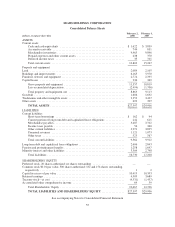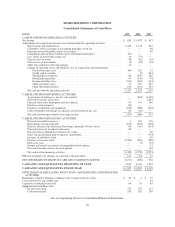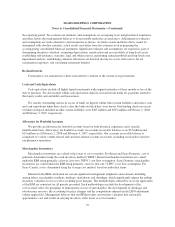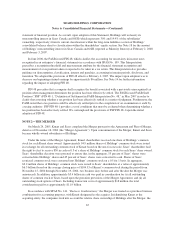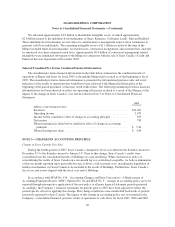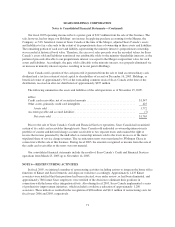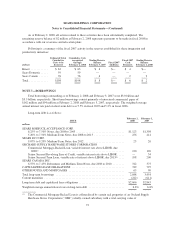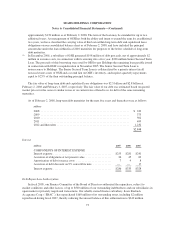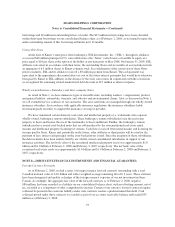Sears 2007 Annual Report Download - page 65
Download and view the complete annual report
Please find page 65 of the 2007 Sears annual report below. You can navigate through the pages in the report by either clicking on the pages listed below, or by using the keyword search tool below to find specific information within the annual report.SEARS HOLDINGS CORPORATION
Notes to Consolidated Financial Statements—(Continued)
Advertising Costs
Advertising costs are expensed as incurred, generally the first time the advertising occurs, and amounted to
$2.2 billion, $2.2 billion, and $2.1 billion for fiscal 2007, fiscal 2006, and fiscal 2005, respectively. These costs
are included within selling and administrative expenses in the accompanying consolidated statements of income.
Income Taxes
We account for income taxes under SFAS No. 109 and FIN 48. Accordingly, we provide deferred income
tax assets and liabilities based on the estimated future tax effects of differences between the financial and tax
basis of assets and liabilities based on currently enacted tax laws. The tax balances and income tax expense
recognized by us are based on management’s interpretation of the tax laws of multiple jurisdictions. Income tax
expense also reflects our best estimates and assumptions regarding, among other things, the level of future
taxable income and tax planning. Future changes in tax laws, changes in projected levels of taxable income, tax
planning, and adoption and implementation of new accounting standards could impact the effective tax rate and
tax balances recorded by us.
Stock-based Compensation
We account for stock-based compensation arrangements in accordance with SFAS No. 123(R), “Share-
Based Payments.” SFAS 123(R) requires us to recognize as expense the fair value of all stock-based
compensation awards including stock options, an accounting method that we adopted voluntarily in fiscal 2003,
and classification of excess tax benefits associated with share-based compensation deductions as cash from
financing activities rather than cash from operating activities. We recognize compensation expense as awards
vest on a straight-line basis over the requisite service period of the award.
Earnings Per Common Share
Basic earnings per common share is calculated by dividing net income available to common shareholders by
the weighted average number of common shares outstanding for each period. Diluted earnings per common share
also includes the dilutive effect of potential common shares: exercise of stock options and the effect of restricted
stock when dilutive.
New Accounting Pronouncements
In December 2007, the FASB issued SFAS No. 141(R), “Business Combinations” which revised SFAS
No. 141, “Business Combinations”. SFAS No. 141(R) is effective for fiscal years beginning on or after
December 15, 2008, with early adoption prohibited. SFAS No. 141(R) will have a significant impact on the
accounting for transaction costs, restructuring costs as well as the initial recognition of contingent assets and
liabilities assumed during a business combination. The provisions of SFAS No. 141(R) are applied prospectively
from the date of adoption, except for adjustments to a previously acquired entity’s deferred tax assets and
uncertain tax position balances occurring outside the measurement period, which are recorded as a component of
income tax expense in the period of adjustment, rather than goodwill. We have not yet assessed the impact this
statement will have on our financial statements.
In September 2006, the FASB issued SFAS No. 157, “Fair Value Measurements.” SFAS No. 157 defines
fair value, establishes a framework for measuring fair value in generally accepted accounting principles and
expands disclosures about fair value measurements. This Statement applies under other accounting
pronouncements that require or permit fair value measurements, the FASB having previously concluded in those
65


